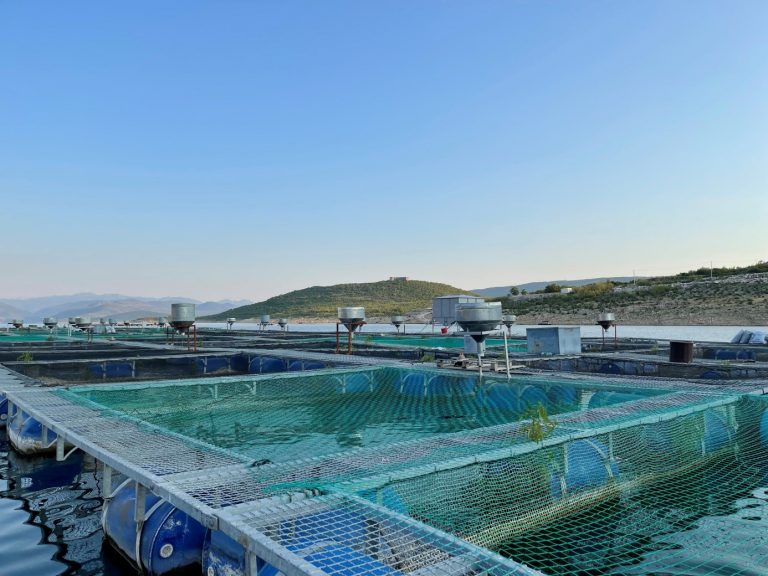Study on Possibilities of Use of Trebisnjica District River Basin for the Fish Cage Farming
Investor: MH Power Utility of Republika Srpska, Associated company Hydro Power Plants on Trebisnjica Ltd, Trebinje
Period of implementation: 2021-2022
Multipurpose system for use, organization and protection against flooding of Trebisnjica river basin is one of the biggest and by configuration most complex integrated development designs in the water sector implemented in the area of South Europe. Beside production of electricity, this system should fulfil also other set elements of the complex target structure in the field of economy, water management, agriculture, recreation and sport.
This Study analyses possibilities and available capacities of water resources in the area of Trebisnjica river basin district in Republika Srpska for the fish cage farming, respecting valid standards and Rule books, first of all regarding environment and water area. Key objects of water management systems are multipurpose reservoirs, which, except storing water for electricity production, also fulfils conditions of active flood protection, providing water for irrigation, conditions for development of tourism, recreation and sport. On the area of Trebisnjica hydro system there are 5 reservoirs: Bileca and Trebinje on Trebisnjica, Vrba and Klinje on Musnica and Alagovac in Nevesinjsko polje.

Use of cages is becoming more popular method of fish farming meaning relatively low initial costs, simple technology and management methods. This method of farming is different compared to classic fish farming since those are open systems, where we have direct interaction between fish from the farm with immediate, natural environment. Intensive works on setting the cages and preparation of the farm can affect the water quality, biomass and diversity of benthos, planktons and nektons, as communities naturally found in freshwater ecosystems. For the successful fish cage farming in reservoirs, it is most important to make right choice of location, and there should be taken care that cages have good access and that water quality is good.
In our region, mostly cold water fish (mostly rainbow trout) and warm water fish (mostly carp).
For the purpose of reviewing possibilities of additional farming capacities of the cage type on the reservoirs in subject, it is very important to identify physical and chemical parameters during unfavorable periods for fish farming, i.e during summer when there is surface water layers temperature increase and in this regard fall of oxygen saturation.
Those two parameters, water temperature and oxygen saturation represent limitation but also determination factors to suggest type of fish farming type and sort of fish. Also, it was necessary to check if there is organic load since on Bilecko and Trebisnjsko lakes there are already fish ponds.
Ichthyofaunal of those reservoirs, consists of non-native (foreign) types which originate from the Black Sea but also Adriatic catchment which came into those reservoirs either by plan – by stocking or without plan – as accidental „passengers“ along with material for stocking or simply by carelessness and irresponsible behavior of individuals, i.e. activity of individuals who brought them into the reservoir. Those species are not just present in reservoirs but have already acclimatized, i.e. adjusted to new environmental conditions and set, now almost natural population and started multiplying in reservoirs.
According to fish fauna it can be concluded that Bileća reservoir has dominantly carp (cyprinid) character i.e. it is suitable for so called warm water fish, Trebinje reservoir shows suitability for trout considering composition of species within and success of acclimatization in its water, reservoir Klinje and Vrba reservoir have trout character i.e they are suitable for so called cold fish types, while Alagovac reservoir is suitable for carps.
In order to define dynamics of replacement of water in reservoir, volumes of reservoirs have been analysed, as well as mean inflow and discharge. Based on implemented analyses it is evident that replacement in reservoirs Bileća, Trebinje Klinje and Vrba are potentially favorable for aquaculture development.
Since Alagovac reservoir is used for water supply and at this moment it has unknown inflow and outflow parameters it was not further considered as potential area for fish cage farming, since it can and will cause deterioration of water quality in this reservoir as consequence of fish farming, and from the water supply point it is impermissible.
Klinje reservoir has small volume and area, so it has been declared for geo-morphological monument of nature. Amendments to the Spatial plan of Republika Srpska by 2025 foreseen to proclaim this area into the park of nature (category V). By the Strategy of Gacko municipality 2022-2028 it was foreseen to make the water intake development on Klinje and Vrba reservoirs. Considering all, it was concluded that this Klinje reservoir has no potential for using its water resources for the fish cage farming.
By implemented preliminary investigations, based on available data and maps, it was concluded that on Bilećko jezero lake it is possible to set additional ponds of cage type for the carp farming, on Trebinjsko jezero lake it is possible to set additional ponds of cage type for the trout farming, and if Vrba reservoir is finally not used for water supply, it is possible to set the fishpond of cage type for trout breeding on this lake.

Before starting the construction of the fishponds of cage type, it was necessary to observe important physical and chemical parameters for each location individually, at least on the level of one year, with resolution of measuring/sampling at least once per month. Development of the Preliminary design, Detailed Designs and Environmental impacts Study could start after processing all the observed data. Along with stated investigations for each suggested position, this documentation would precisely describe, proscribe and set detail plan and design documentation for each potential fish farm.
In Preliminary design, it would be necessary to develop document which would precisely describe technology of fish farming and present more precise costs of investments, incomes and expenses on annual level (techno-economic analyses) what would serve as kind of supplement and base for investment in this filed, on above analyzed reservoirs.


